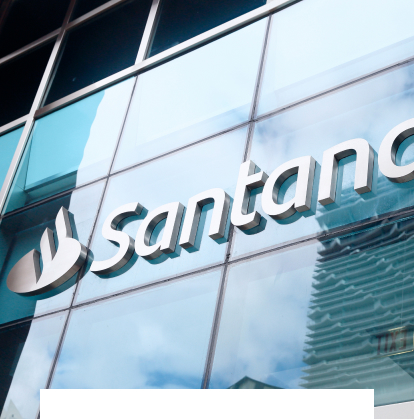Pass-through Insurance Alternative Record-Keeping | Santander Bank - Santander


FDIC pass-through insurance alternative record-keeping
Alternative record-keeping allows third-party fund owners to electronically submit necessary information to expedite an insurance determination. By this method, files are only submitted in the event of failure, based on requirements outlined in the FDIC Deposit Brokers Processing Guide.
Submission directly to FDIC
All third-party account holders storing funds owner data are eligible to submit a file to the FDIC, in lieu of Santander doing so, irrespective of whether such third-party account owners are deposit brokers or not. Files may be submitted by mail to the FDIC directly at the address at right however, this manual processing may result in a lengthier deposit insurance determination.
Federal Deposit Insurance Corporation
Attention: Shelia Lollie
600 north Pearl Street, Suite 700
Dallas, TX 75201
FDIC transmission
Santander has developed an ad hoc transmission process for third-party pass-through account holders or servicers to submit alternative record-keeping files in the unlikely event the bank is placed into receivership by the FDIC. This process is kept simple to minimize processing delays. In the event of bank failure, Santander customers could obtain credentials to use our secure transmission portal, called Intralinks, to submit owner data within 24 hours of Santander failure.Submitting an ad hoc transmission
In the event of a Santander failure, follow the below instructions. Santander welcomes owners of any account-holding third-party customer funds to test this transmission functionality by executing the same below. For more information on submitting a test file, please send an email to FDIC370Pass3PartyTest@santander.us.
Follow these 3 steps
- Subject line of email must read “ARE Portal Access Request”
- Customer entity name
- Customer entity phone number
- Customer entity address
- Primary customer contact name, email, and phone number
- Customer alternate contact (name, email, and phone number if applicable)
You will receive an email from Intralinks with instructions on how to activate your account so your file(s) can be submitted.
The FDIC requires an ASCII flat, tab-delimited file, which is a text file with extension. Please leverage the "ARE_Submission Template_v1" provided below as a Microsoft Excel file for this purpose; the file consists of columns with header records. The columns follow the prescribed FDIC broker submission format, followed by 10 Addendum Fields, with a few Santander-specific columns. All columns highlighted in grey are required fields for submission.
Download_ARE_Submission Template_v3.xlsx
After populating the file with the required information, take the following steps to ensure your file is in the correct format:
- Save as a tab-delimited text file (.txt) using the following naming format:
customername_YYYYMMDD_v_data.txt
NOTE: Your customer name should be all lowercase and sequence starts with 1 and ascends with each additional file. For example: abccompany_20230101_v1_data.txt
When creating this alternative record-keeping file, please note the following:
- Unique Identifier Permissible: FDIC guidance indicates the "customer account number" field is optional. This field is required by Santander and allows you to assign a unique identifier to each account in the file for easier reconciliation.
- If an account holder owns any balances in the account for which the file is being submitted, the account holder must include their own entity information in the alternative record-keeping file to identify those balances—in order to distinguish them from funds owned by the account owner's third-party customers.
- Ownership Rights & Capacity (ORC): This is a required field. you can use the following chart to determine the applicable ORC code. View ORC Chart.
documentation for the Ad-Hoc FDIC Transmission.
Santander will review documentation and reach out through email if we identify any errors in the file that would prevent it
from processing properly.
Still have questions? We’re here to help.

Visit Us
Get in touch
| Type of ORC | ORC Code | Simple Desciption | FDIC Description |
| Single | SGL | A single account is a deposit owned by a single natural person. | |
| Joint | JNT | A joint account is a deposit owned by two or more people. FDIC insurance covers joint accounts owned in any manner conforming to applicable state law, such as joint tenants with right of survivorship, tenants by the entirety, and tenants in common. | |
| Trust Accounts | TST | Trust accounts are deposit accounts held in connection with informal revocable trusts, formal revocable trusts, and irrevocable trusts.
| |
| Certain Retirement Accounts | CRA | Certain retirement accounts are self directed retirement deposits for which an owner and not a plan administrator has the right to direct how the funds are invested. (Individual Retirement Account (IRA), Self-directed defined contribution plan account, Self-directed Keogh plan account (or ¾.R.H0 plan account) designed for self-employed individuals, All Section }[7 deferred compensation plan accounts) | |
| Government Accounts | GOV1, GOV2, GOV3 | Government accounts are also known as public unit accounts. This category includes accounts of the federal government, state governments, and other governmental bodies. | |
| Business/Organization Accounts | BUS | Deposits owned by corporations, partnerships, and unincorporated associations, including for-profit and not-for-profit organizations. |

 Equal Housing Lender - Member FDIC
Equal Housing Lender - Member FDIC